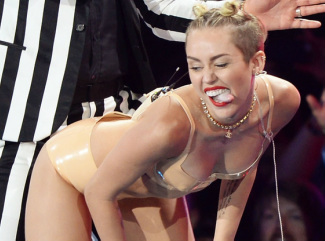 Miley Cyrus twerks during an MTV performance. Miley Cyrus twerks during an MTV performance. Tags: art/music, culture, media, race/ethnicity, bell hooks, cultural appropriation, othering, popular culture, racism, representation, 00 to 05 mins Year: 2013 Length: 3:33 Access: YouTube Summary: The music video for Miley Cyrus’ hit 2013 song “We Can’t Stop” is full of hip-hop tropes, from beats and backtracks to the twerk dance move for which Cyrus became infamous. Instructors can use this clip as a touchstone for classroom discussions about cultural appropriation and representations of otherness in popular media. Instructors can direct students to watch the video while keeping an eye out for how Black women are represented. Black women appear in the video, but only as a backdrop for Cyrus’ twerking along to the line “all my homegirls here with the big butts.” Cyrus' performance at the MTV Video Music Awards also featured Cyrus performing on stage with all Black female dancers around her. Although the use of hip-hop and Black culture by white musicians isn’t anything new, Cyrus’ performance functions as the appropriative practice bell hooks calls “eating the other.” In hooks’ terms, ethnicity serves as a spice or seasoning to give more flavor to an otherwise bland and mainstream/white performance. In the context of mainstream consumer culture, otherness is commodified and used as a way of adding value to a product. For example, when Cyrus was asked about the song, she said, "I want urban, I just want something that just feels Black.” Instructors can have students consider: What does it mean for something to “feel Black” in the context of popular culture? Is Cyrus’ appropriation of twerking problematic? Why or why not? Submitted By: Anya M. Galli
2 Comments
Manuel Franco
7/29/2023 02:13:19 am
I just want to say Thank You to everyone who supported me through the years. My name is Manuel Franco, New Berlin, Wisconsin. My story of how I won the Powerball lottery of $768.4M is a bit of a tale. I have been playing Powerball tickets for 6 years now since I turned 18. I bought my first ticket on my 18 birthday. I was feeling very lucky that day because I had contacted Dr. Odunga Michael to help me with the winning Powerball numbers. I really had that great great feeling that I looked at the camera wanting to wink at it. I only did a tiny part of it and trusted him. He gave me the numbers after I played a couple other tickets along with it for $10. I checked my ticket after the winnings came online and saw the numbers were correct including the Power play. I screamed for about 10 minutes because it felt like a dream. I had won $768.4M. You can check my winning testimony with the lottery officials just with my name search. Thank you Dr Odunga. Well, his email is [email protected] and you can also call or Whats-app him at +2348167159012 so you guys can contact him
Reply
mark hold
7/7/2024 03:59:27 pm
Herbal Penis Enlargement product is 100% guaranteed to Enlarge and get a better ERECTION, the reason why most people are finding it difficult to enlarge Penis is that they believe in medical reports, drugs and medical treatment which is not helpful for Penis Enlargement. Natural roots/herbs are the best remedies which can easily Enlarge your Penis permanently Contact Dr MOSES BUBA via Email: [email protected] or via WhatsApp: +2349060529305. for Natural root and herbal remedies put together to help Enlarge manhood and Erect healthily. I also learn that Dr MOSES BUBA also can cure other types of diseases, HEPATITIS B,DIABETICS,CANCER,HPV,LOW SPERM CAM, HIV/STDS, FIBROSIS LOST OF WEIGHT, BREAST ENLARGEMENT, HIPS and BUMS ENLARGEMENT etc .
Reply
Leave a Reply. |
Tags
All
.
Got any videos?
Are you finding useful videos for your classes? Do you have good videos you use in your own classes? Please consider submitting your videos here and helping us build our database!
|
 RSS Feed
RSS Feed
